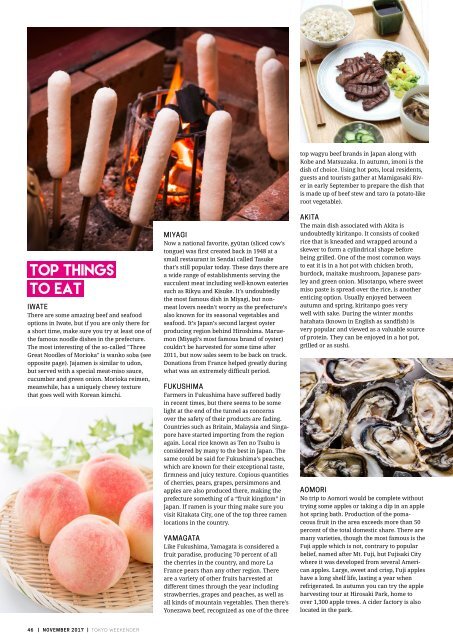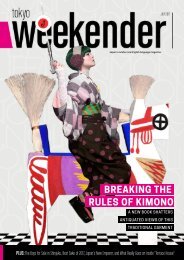Tokyo Weekender - November 2017
Our November issue is out, featuring a jam-packed end-of-year special: 42 Christmas gift shopping ideas and 10 bonenkai spots. Plus: The avant-garde world of butoh dance, Japanese teen prodigies, and a special supplement guide to Akita. Here's where to find a copy around Tokyo: www.tokyoweekender.com/pickup/
Our November issue is out, featuring a jam-packed end-of-year special: 42 Christmas gift shopping ideas and 10 bonenkai spots. Plus: The avant-garde world of butoh dance, Japanese teen prodigies, and a special supplement guide to Akita. Here's where to find a copy around Tokyo: www.tokyoweekender.com/pickup/
Create successful ePaper yourself
Turn your PDF publications into a flip-book with our unique Google optimized e-Paper software.
TOP THINGS<br />
TO EAT<br />
IWATE<br />
There are some amazing beef and seafood<br />
options in Iwate, but if you are only there for<br />
a short time, make sure you try at least one of<br />
the famous noodle dishes in the prefecture.<br />
The most interesting of the so-called "Three<br />
Great Noodles of Morioka" is wanko soba (see<br />
opposite page). Jajamen is similar to udon,<br />
but served with a special meat-miso sauce,<br />
cucumber and green onion. Morioka reimen,<br />
meanwhile, has a uniquely chewy texture<br />
that goes well with Korean kimchi.<br />
MIYAGI<br />
Now a national favorite, gyūtan (sliced cow's<br />
tongue) was first created back in 1948 at a<br />
small restaurant in Sendai called Tasuke<br />
that’s still popular today. These days there are<br />
a wide range of establishments serving the<br />
succulent meat including well-known eateries<br />
such as Rikyu and Kisuke. It's undoubtedly<br />
the most famous dish in Miyagi, but nonmeat<br />
lovers needn't worry as the prefecture’s<br />
also known for its seasonal vegetables and<br />
seafood. It’s Japan’s second largest oyster<br />
producing region behind Hiroshima. Maruemon<br />
(Miyagi’s most famous brand of oyster)<br />
couldn’t be harvested for some time after<br />
2011, but now sales seem to be back on track.<br />
Donations from France helped greatly during<br />
what was an extremely difficult period.<br />
FUKUSHIMA<br />
Farmers in Fukushima have suffered badly<br />
in recent times, but there seems to be some<br />
light at the end of the tunnel as concerns<br />
over the safety of their products are fading.<br />
Countries such as Britain, Malaysia and Singapore<br />
have started importing from the region<br />
again. Local rice known as Ten no Tsubu is<br />
considered by many to the best in Japan. The<br />
same could be said for Fukushima’s peaches,<br />
which are known for their exceptional taste,<br />
firmness and juicy texture. Copious quantities<br />
of cherries, pears, grapes, persimmons and<br />
apples are also produced there, making the<br />
prefecture something of a “fruit kingdom” in<br />
Japan. If ramen is your thing make sure you<br />
visit Kitakata City, one of the top three ramen<br />
locations in the country.<br />
YAMAGATA<br />
Like Fukushima, Yamagata is considered a<br />
fruit paradise, producing 70 percent of all<br />
the cherries in the country, and more La<br />
France pears than any other region. There<br />
are a variety of other fruits harvested at<br />
different times through the year including<br />
strawberries, grapes and peaches, as well as<br />
all kinds of mountain vegetables. Then there's<br />
Yonezawa beef, recognized as one of the three<br />
top wagyu beef brands in Japan along with<br />
Kobe and Matsuzaka. In autumn, imoni is the<br />
dish of choice. Using hot pots, local residents,<br />
guests and tourists gather at Mamigasaki River<br />
in early September to prepare the dish that<br />
is made up of beef stew and taro (a potato-like<br />
root vegetable).<br />
AKITA<br />
The main dish associated with Akita is<br />
undoubtedly kiritanpo. It consists of cooked<br />
rice that is kneaded and wrapped around a<br />
skewer to form a cylindrical shape before<br />
being grilled. One of the most common ways<br />
to eat it is in a hot pot with chicken broth,<br />
burdock, maitake mushroom, Japanese parsley<br />
and green onion. Misotanpo, where sweet<br />
miso paste is spread over the rice, is another<br />
enticing option. Usually enjoyed between<br />
autumn and spring, kiritanpo goes very<br />
well with sake. During the winter months<br />
hatahata (known in English as sandfish) is<br />
very popular and viewed as a valuable source<br />
of protein. They can be enjoyed in a hot pot,<br />
grilled or as sushi.<br />
AOMORI<br />
No trip to Aomori would be complete without<br />
trying some apples or taking a dip in an apple<br />
hot spring bath. Production of the pomaceous<br />
fruit in the area exceeds more than 50<br />
percent of the total domestic share. There are<br />
many varieties, though the most famous is the<br />
Fuji apple which is not, contrary to popular<br />
belief, named after Mt. Fuji, but Fujisaki City<br />
where it was developed from several American<br />
apples. Large, sweet and crisp, Fuji apples<br />
have a long shelf life, lasting a year when<br />
refrigerated. In autumn you can try the apple<br />
harvesting tour at Hirosaki Park, home to<br />
over 1,300 apple trees. A cider factory is also<br />
located in the park.<br />
46 | NOVEMBER <strong>2017</strong> | TOKYO WEEKENDER
















